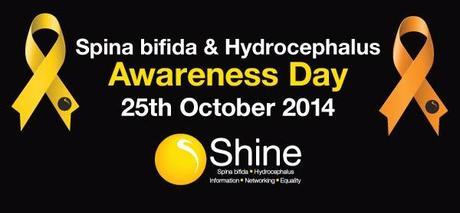
“It's WORLD #SpinaBifida and #Hydrocephalus Awareness Day! #WSBHD :) #SpreadTheWord http://thndr.it/1y2NpMi”
Shine’s annual Spina bifida and Hydrocephalus Awareness Week aims to raise awareness of the conditions, while celebrating the fantastic achievements made by its energetic and growing community.The third Spina bifida and Hydrocephalus Awareness Week will take place across England, Wales, and Northern Ireland from 19th-26th October 2014.To mark the week, Shine encourages people to take part in its Wear Yellow and Shine initiative, which raised over £20,000 in 2013 to help the charity support everyone affected by spina bifida and hydrocephalus.This year, in addition to Wear Yellow and Shine, we are launching a new initiative called #shinereflections, which aims to help boost awareness among Shine’s growing membership and active online community. This is very close to my heart as my daughter Millie was born 10 weeks early & is disabled with hydrocephalus, you can read the full blog post of my birth story over on http://preciouslittleworlds.blogspot.co.uk/2013/08/my-precious-millie-born-10-weeks-early.html Trying to get across more awareness of hydrocephalus as sometimes feel that some disabilities plus life threatening illnesses can get over looked.First of all going to kick off more on the subject-
This is very close to my heart as my daughter Millie was born 10 weeks early & is disabled with hydrocephalus, you can read the full blog post of my birth story over on http://preciouslittleworlds.blogspot.co.uk/2013/08/my-precious-millie-born-10-weeks-early.html Trying to get across more awareness of hydrocephalus as sometimes feel that some disabilities plus life threatening illnesses can get over looked.First of all going to kick off more on the subject- What is hydrocephalus
Hydrocephalus is a build-up of fluid on the brain. The excess fluid puts pressure on the brain, which can damage it.The damage to the brain can result in a wide range of symptoms, including:
- headache
- being sick
- blurred vision
- difficulty walking
Causes
In the past, hydrocephalus was often referred to as ‘water on the brain’. However, the brain is not surrounded by water but by a special fluid called cerebrospinal fluid (CSF).CSF has three important functions, it:- protects the brain from damage
- removes waste products from the brain
- provides the brain with the nutrients it needs to function properly
Types of hydrocephalus
There are three main types of hydrocephalus:- hydrocephalus that's present at birth (congenital hydrocephalus)
- hydrocephalus that develops after birth (acquired hydrocephalus)
- hydrocephalus that usually only develops in older people (normal pressure hydrocephalus or NPH)
Congenital hydrocephalus
Congenital hydrocephalus is present in babies when they're born and can be caused by birth defects, such as spina bifida, or as a result of an infection the mother develops during pregnancy, such as mumps or rubella (German measles).It's estimated that spina bifida affects one baby in every 1,000 born in Britain. Most of them will have hydrocephalus.Congenital hydrocephalus carries the risk of long-term mental and physical disabilities as a result of permanent brain damage.Read more information about complications of hydrocephalus.Acquired hydrocephalus
Acquired hydrocephalus can affect children or adults. It usually develops after an injury or illness. For example, it may occur after a serious head injury or as a complication of a medical condition, such as a brain tumour.Read more about the causes of hydrocephalus.Normal pressure hydrocephalus
Normal pressure hydrocephalus (NPH) is a poorly understood condition that usually only affects people over 50 years old.It can sometimes develop after an injury or a stroke, but in most cases the cause is unknown.The average age of people with NPH is 75, although it's a rare condition. In 2009-2010, there were just under 1,000 recorded cases in England. However, the true number may be higher.Lots of information for you and yes its alot to take in , so what will we be doing for this day? I have bought lots of shine goodies as the day involves "Wear Yellow And Shine" Will be going out and about spreading the word . Some are also raising money with coffee & cake I tend to bake some yummy cupcake to join in.Yes its going to be a fun filled day will be posting more on what we having been upto for today later on.
I have bought lots of shine goodies as the day involves "Wear Yellow And Shine" Will be going out and about spreading the word . Some are also raising money with coffee & cake I tend to bake some yummy cupcake to join in.Yes its going to be a fun filled day will be posting more on what we having been upto for today later on.

http://preciouslittleworlds.blogspot.com
